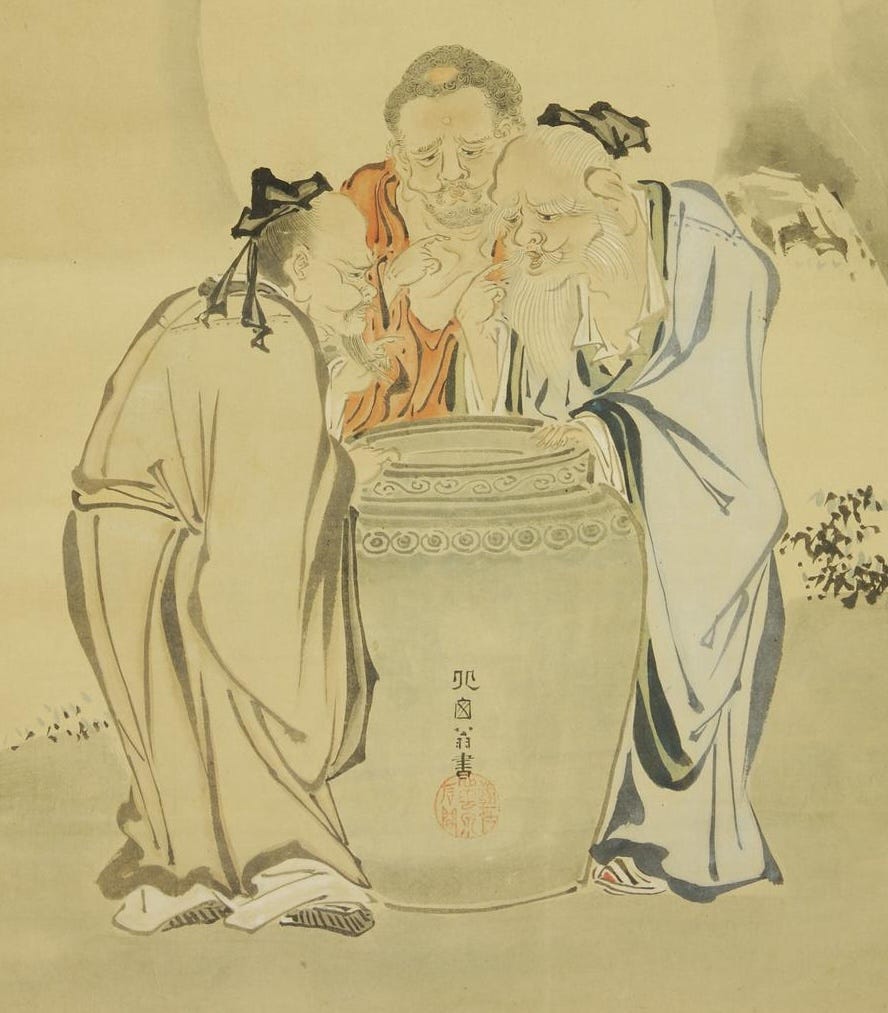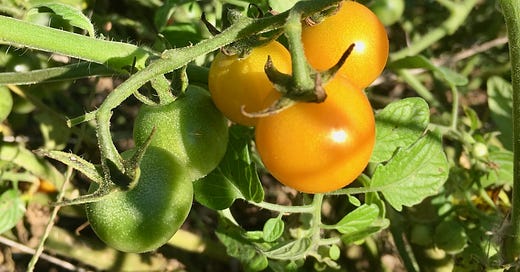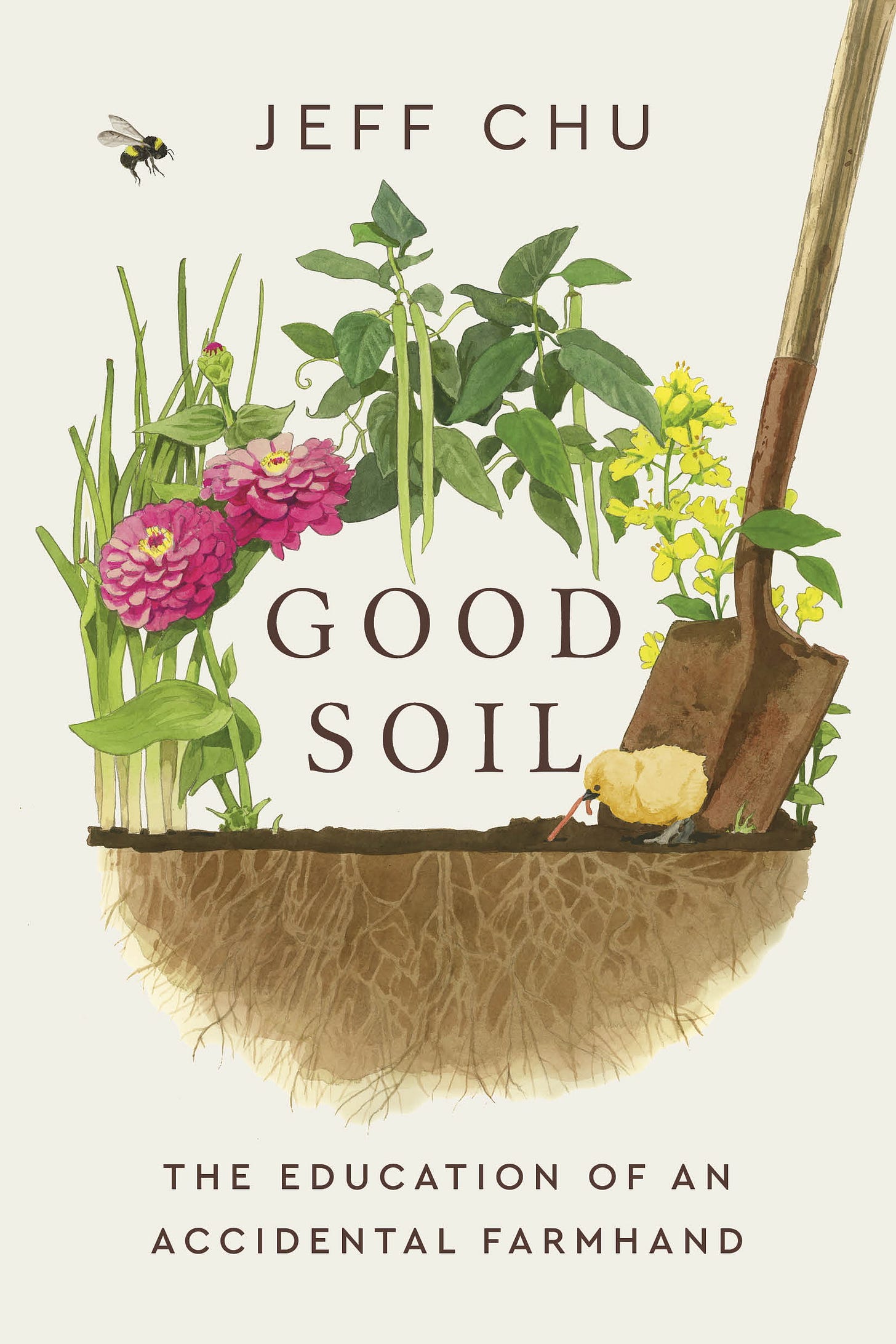Lent IV: Sweet
Some fragmented thoughts on gummy bears, Sun Sugar tomatoes, the consolation of sweetness, harmony of flavors, and bearing true witness in a season of lies
March 29, 2025
Grand Rapids, Mich.
I rarely eat candy—I don’t have much of a sweet tooth—but the other day, mid-afternoon, I felt my blood sugar dropping. I fished a little packet of gummy bears out of my backpack—who knows how long it had been there?—and gradually began working my way through. I ate them according to the proper method: I bit the head off each bear first, then continued onto the body.
Sweetness, at its best, is reward and relief. I do not like anything approaching cloying, whether in a personality or wine or dessert. It can’t be trusted. It oversaturates. It overwhelms. Like all the other flavors, sweetness needs balance.
“Merry and sweet is the blessed and lovely demeanour of our Lord towards our souls,” the sage and mystic Julian of Norwich writes in her super-weird Revelations of Divine Love. “For he saw us always living in love-longing.”
--
Everyone always wanted to harvest tomatoes, because you got to eat as you worked.
The most popular thing in the garden was undoubtedly the Sun Sugar, a hybrid cherry tomato whose name tells you what you need to know—bright, orange, and bursting with sweetness. Pluck a leaf off a nearby basil plant, wrap the tomato, and you had a nearly perfect bite; if only you’d had a morsel of fresh mozzarella, too.
--
I went through the Bible the other day to review the explicit appearances of sweetness. Almost always, “sweet” appears in contrast to that which is not.
At Marah, at the behest of the thirsty, complaining Israelites, Moses cries out to God, who shows him a piece of wood, which he throws into bitter water. Then, the text says, “the water became sweet.”
When his people feel the grievous weight of the law, Nehemiah prescribes sweet wine as something of an antidote. “For this day is holy to our Lord,” he says, “and do not be grieved, for the joy of the Lord is your strength.”
“Sweet is the sleep of laborers,” the Teacher writes in Ecclesiastes.
Amidst their bleak prophecies, both Joel and Amos speak of a time when “the mountains shall drip sweet wine.”
Sweetness, at its best, is comfort and consolation. We don’t always know what’s good for us, though, and we keep chasing that sugar rush. Scientists have been studying sugar’s effects on the human brain; some have hypothesized that it is addictive.
--
Only at the beginning of August did our tomatoes begin to come in. Heirloom varieties hadn’t done that well in the garden.
Nate suspected the still-depleted soil, even enriched by our compost, wasn’t yet robust enough for them. This year, we tried a type called Berkeley Tie-Dye— I’d been tempted by the pictures in the seed catalog of their intriguing striations of green and red— but they struggled.
The Sun Sugars, though, thrived as usual. Everyone loves these little orange orbs of sweetness. As we made our way down the rows, plucking the fruit off the vines, nearly as many ended up in our mouths as in the buckets for the CSA.
Our favorites among these favorites weren’t the deep orange, textbook Sun Sugars. Once in a while, I’d spot one that was paler, more pinkish, a little less attention-grabbing. These tasted almost like little cantaloupes. We thought they were a different variety at first, something new that we’d planted without even realizing it. Then we realized Nate had saved seed from last season’s crop. The thing about a parent hybrid tomato is that its seeds won’t necessarily produce identical tomato babies. Genes can surprise you, lying dormant for a generation before popping up again. We hypothesized that the hybrid must have dehybridized.
Everyone wanted these tomatoes.
--
Those mutant Sun Sugars were sweet, yes, but not overly so. They were more balanced, more tart, somehow brighter. Their flavor was alive—and they reminded me that the best kind of sweetness comes with some element of surprise.
At risk of offending my people, let me say that Chinese desserts are typically awful. To my palate, mooncakes are leaden and overly sweet, and the traditional red-bean soup is a bowlful of sugar-laden drudgery. Fortunately, so many Chinese restaurants don’t bother, just slicing up oranges and tossing a few fortune cookies at you, along with the check, at meal’s end.
Yet sugar has a valuable presence on the Cantonese table. It is the secret ingredient in some of its most delectable dishes. Used sparingly, its presence might be known only to those who cook. Maltose, which is about half as sweet as regular sugar, is crucial to the glossy sheen on cha siu (barbecued pork) and roasted duck. Steamed fish cooked at home will never taste the same at those in restaurants, unless you know to buy the particular kind of seasoned soy sauce that’s typically used to finish seafood dishes; it’s lighter than regular soy sauce, and slightly sweetened. My mother’s egg and tomato, a classic homestyle Cantonese dish, has just a touch of sugar, which balances out the tang of the vinegar in the gravy and enhances the natural sweetness of the tomatoes.
In all these preparations, you never want to notice the sweetness. Used with restraint, sugar lets the savory notes sing. Always, harmony is the goal.
--
Jesus loved his friends “eis telos,” John tells us. The phrase can be translated “till the end,” but it can also be rendered “to perfection.”
Eis telos.
Some days after the Last Supper, Jesus cooked breakfast for his friends on the beach. The Last Supper, it turns out, is a misnomer. It wasn’t their last meal together, because, as the story goes, Jesus loved them through death and onward to resurrection— in that sweeping cosmic way, yes, but also in the small things that mark our lives. Fish grilled on the flames, bread baked in the hot coals, stories shared around a warming fire.
Eis telos.
I suppose “till the end” can sound ominous. But heard another way, it’s also an invitation, pregnant with possibility. It invites us to listen in the midst of disagreement and to wrestle with our discomfort and to share laughter and to shed tears of solidarity. Love grows, but so often it takes its sweet time. This is not how I thought the story would end, but this is how it did.
Eis telos.
Where is the end, and what is the end? On the farm, I found belonging I never expected— but longing, too. I came to understand my own mattering better— but also others’ mattering, and my entanglement with that, too. I began to send some things to my own personal compost pile, recognizing what I had to surrender to death so that something else might come to life. I’m not sure how good the soil is quite yet. Maybe the heirloom tomatoes will flourish next year? But it’s a comfort, I guess, to know how the process works.
Eis telos.
I don’t think you have to believe in Christian theology or hold any interest in the Christian faith to be inspired by John’s testimony that his dear friend loved him and so many others so well. It makes me want to experience that kind of belonging. It also compels me to extend it to others— to still the waters, to create space, to offer refuge.
The wider world is not much different from the farm. It carries so many wounds and scars. It offers so much beauty. Its resilience is remarkable. Grief is inevitable and real. So is the invitation to participate in healing and proclaim grace, to believe again in goodness and live a life of hope.
Eis telos.
--
There’s a traditional motif in Chinese painting called the Vinegar Tasters that shows three wizened men gathered around a vat of vinegar. Each man has a different facial expression, representing their reactions to the vinegar. (Yes, the differences are subtle.)

Most often, the three men are read as the three greats of Chinese religion: Confucius, Buddha, and Lao Tzu. Confucius perceives the vinegar as sour, reflecting his sour outlook on humanity and life. Buddha, seeing life as marked by suffering, has a bitter mien. Lao Tzu is the one closest to smiling; Taoism’s father taught radical acceptance, and in the paintings’ context, his sense of sweetness came from his acknowledgment that the vinegar was exactly what it was supposed to be.
One reading of the motif, which I appreciate, is that Chinese philosophy properly interweaves all these three. None of these perceptions of humanity is entirely correct, but something approaching truth can be found at their intersection. There’s also a “yes, and...” here: Only a weirdo (or, I suppose, a vinegar maker) just sits at that vat of vinegar, tasting it. Vinegar is typically experienced in a fuller context, in which sourness and bitterness are tempered and balanced by the salty and the sweet. Isn’t the key to acknowledge all the different flavors?
Throughout Lent, I have repeatedly been thinking about one particular commandment: Thou shalt not bear false witness. I suppose it has come to mind and heart again and again because of the flourishing of lies, but I don’t just mean the untruths that we have been hearing from politicians and propagandists. Those of us who are angered by much of what we are witnessing in the world around us can be equally prone to hyperbolic catastrophizing, such that we fail to recognize what’s still possible and to identify what is good. That, too, is bearing false witness.
There is plenty to grieve in the world around us—the dehumanization and violence, both natural tragedies (let us send up a prayer for the people of Myanmar as they pick through the rubble of the devastating earthquake) and manmade ones (so much unending war). We ought to name these things and reckon with their realities. And also: In the examples of aid workers and activists, in the living testimony of those who feed and those who heal, we see the resilience and goodness of humanity. We ought to name these things and reckon with their realities, too. In reflecting on that good, we receive an invitation to do likewise, moving through the world with mercy and grace.
We, too, can recognize the love-longing in us and around us. We, too, can help create the merry and the sweet.
[The italicized portions of the above essay are adapted excerpts from Good Soil: The Education of an Accidental Farmhand, just published by Convergent/Penguin Random House on March 25th. This is Part IV of a Lenten series on the flavors. Here are the links to Part I: Bitter, Part II: Sour, and Part III: Salty.]
A note of gratitude: Thank you for welcoming Good Soil into the world with such generosity. If you don’t have a copy yet, please buy one wherever you like to buy books.
Some weeks ago, knowing my culturally ingrained hesitation to promote the book, my lovely editor, Derek Reed, sent me a note of encouragement: “You should feel zero guilt about spreading the word about this book right now, even with all that’s going on in the world,” he wrote. “This book is a gift—an escape into beauty at a time when we need that, but also a reminder of the hard, necessary work it takes to show up for others and treat ourselves more gently.”
This week, I will be showing up in Nashville, Chattanooga, Memphis, Little Rock, Houston, and Austin. I’m looking forward to being with some of the loveliest humans along the way—Margaret Renkl in Nashville, Barbara Brown Taylor in Memphis, Sarah Bessey in Houston and Austin. Please join us. I’d love to be able to greet you in person somewhere along the way; here’s the full tour schedule.
In the meantime, please keep this introvert in your thoughts and prayers. Also please let me know what I can be praying for on your behalf—and if you’ve already read Good Soil, I’d love to know what you think, what resonates, what doesn’t, and where you might have questions or quibbles.
With gratitude and in hope,
Jeff
p.s. You can find my mom’s recipe for egg and tomato in this earlier installment of the newsletter.
p.p.s. I’ve had the chance to be interrogated in the best way by some kind folks. Here’s my interview with Sarah Bessey. Here’s one with Erin Moon. And here’s a conversation with Meredith Miller.






I’m reading Good Soil aloud because it calls me to do that. Thank you. It’s so beautiful. Also just watched my last Berkeley tie dye tomato wilt over and die. I was not reading the book to them! That’s a note about how my gardening is going as well as appreciation that the Farminary lost its tie dyes. Onward to the second round of seedlings (not tie dyes)!
I’m such a dorky introvert outside my work life. As a Vet Tech I love my patients and their guardians but once home..it’s me and the garden so when I read this today it struck such a longing chord in me..I’d forgotten what John had spoke. ..thank you for this reminder ❤️
“I don’t think you have to believe in Christian theology or hold any interest in the Christian faith to be inspired by John’s testimony that his dear friend loved him and so many others so well. It makes me want to experience that kind of belonging. It also compels me to extend it to others— to still the waters, to create space, to offer refuge..”